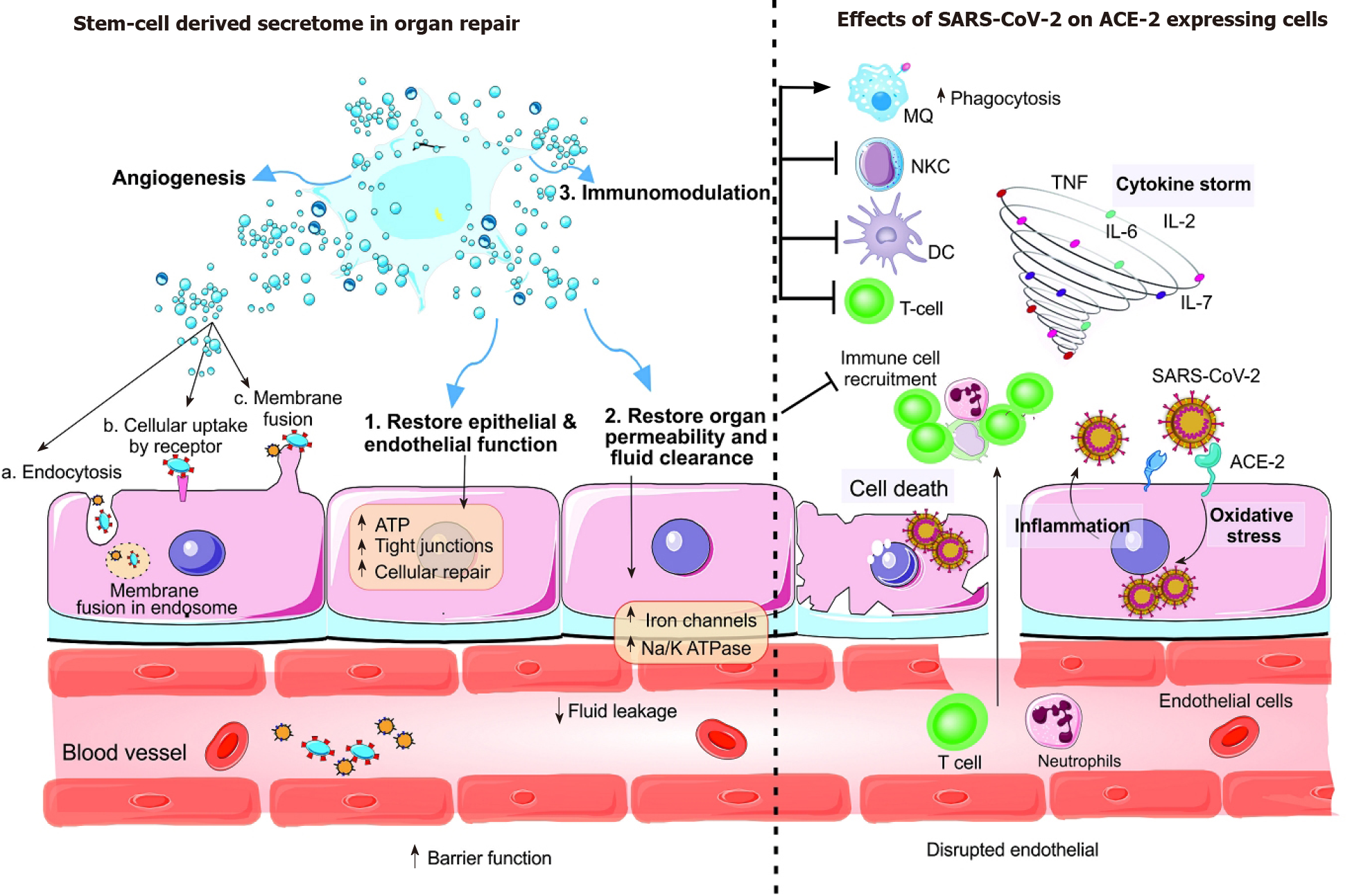Copyright
©The Author(s) 2021.
World J Stem Cells. Dec 26, 2021; 13(12): 1813-1825
Published online Dec 26, 2021. doi: 10.4252/wjsc.v13.i12.1813
Published online Dec 26, 2021. doi: 10.4252/wjsc.v13.i12.1813
Figure 1 The stem cell secretome.
After the interaction between host angiotensin-converting enzyme 2 (ACE2) receptor and the spike S protein of severe acute respiratory syndrome coronavirus 2, the membrane is fused, and the viral genome is released into the cell or the virus enters the cell by clathrin-dependent/independent endocytosis. Most of the cells in human organs including the intestine, heart, kidney, and alveolar type II (AT2) cells of the lungs express ACE2 receptors. Extracellular matrix metalloproteinase inhibitor (EMMPRIN or CD147) and two proteases transmembrane serine protease 2 (TMPRSS2) are required for virus entry into the host cell. The lungs are damaged after direct destruction of capillary endothelial cells and AT2, the renin-angiotensin system is disrupted or the immune response is diminished indirectly. Following virus-induced infection, pathogen-associated molecular patterns lead to recognition of the virus by the innate immune system, activation of nuclear factor-κappa B and IRF3 pathways, type I interferon (IFN) expression and consequently activation of the JAK/STAT pathway and finally the expression of IFN-stimulated genes (ISG) which have anti-viral activity. The abovementioned effective immune response is required for successful virus clearance and clinical disappearance of the disease. Nonetheless, the IFN response may be delayed due to evasion of IFN and ISG mediated killing by the virus which in turns leads to hyper-inflammatory neutrophils and macrophage infiltration at the pulmonary site accompanied by pro-inflammatory cytokines including granulocyte-colony stimulating factor, tumor necrosis factor, MCP1, and interleukin-1b/2/6/7/8/17[3]. This hyper-activation of T lymphocytes and the innate response is called the ‘cytokine storm’ and is responsible for lung disorders including acute respiratory distress syndrome, pneumonitis, viral sepsis, respiratory and organ failure. A high number of pro-inflammatory cytokines leads to hyaluronan synthase 2 induction which elevates hyaluronan production and fluid accumulation in the lungs[78]. In critical cases of coronavirus disease 2019, the virus enters the peripheral blood and translocates to various target organs including kidney, heart, and intestine and can cause multiple organ failure. ACE2: Angiotensin-converting enzyme 2; SARS-CoV-2: Severe acute respiratory syndrome coronavirus 2; TNF: Tumor necrosis factor; IL: Interleukin; DC: Dendritic cell.
- Citation: Ardalan M, Chodari L, Zununi Vahed S, Hosseiniyan Khatibi SM, Eftekhari A, Davaran S, Cucchiarini M, Roshangar L, Ahmadian E. Stem cell-derived biofactors fight against coronavirus infection. World J Stem Cells 2021; 13(12): 1813-1825
- URL: https://www.wjgnet.com/1948-0210/full/v13/i12/1813.htm
- DOI: https://dx.doi.org/10.4252/wjsc.v13.i12.1813









